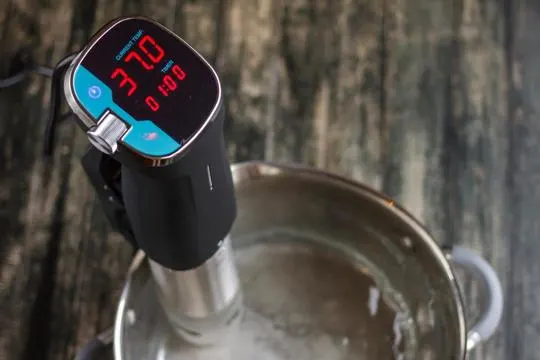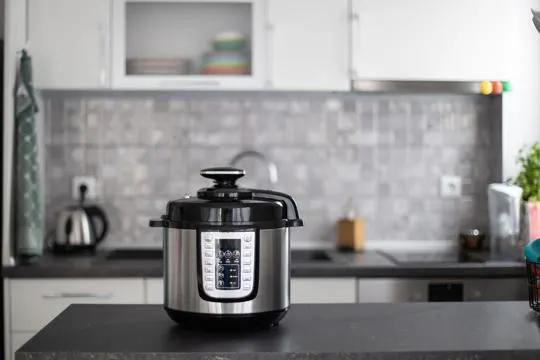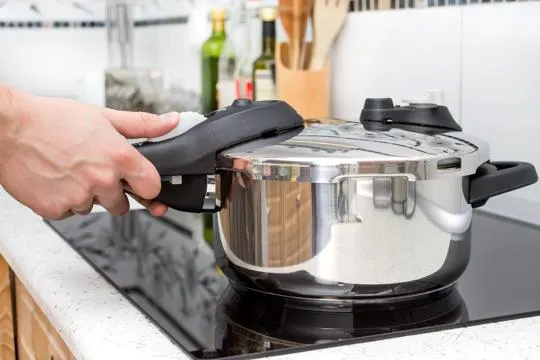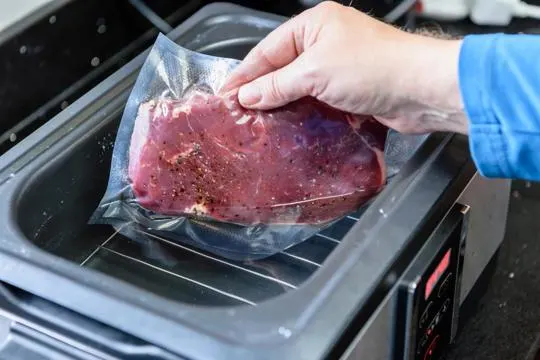Summary of key points
The main difference between sous vide and pressure cooker lies in their cooking methods and the types of dishes they are best suited for. Sous vide involves cooking food in a vacuum-sealed bag submerged in hot water for an extended period, while pressure cookers use steam and intense pressure to rapidly cook food.
Sous vide is ideal for cooking delicate foods like fish or eggs, as well as evenly cooking meats to desired levels of doneness. Pressure cookers, on the other hand, are great for quickly cooking tough cuts of meat or making soups and stews in a fraction of the time.
Sous vide and pressure cookers seem like gadgets from a sci-fi kitchen, right?
Well, we’re here to break it down. Both methods transform raw ingredients into mouth-watering meals. Sous vide, a fancy term for cooking food sealed in a bag, in a water bath at a precise temperature. It’s like giving your steak a spa day, ending with it cooked to perfection.
On the flip side, pressure cookers are the speedy Gonzales of cooking. They use high pressure to cook food fast. Think beans ready in minutes, not hours.
We’ve had our mishaps in the kitchen. Rubber chicken, anyone? Yet, these tools helped us fare better.
So, if you’ve got a busy life or just value your time, understanding these two can be a game changer.
What is Sous Vide?

Sous vide is a popular cooking process.
Food is sealed in a bag and then placed in a temperature-controlled water bath.
Cooking this way is done at a lower temperature for longer, locking in moisture and flavor.
This also tenderizes tough cuts of meat for juicy dishes.
What makes sous vide unique is its ability to evenly cook food from edge to edge.
Plus, the precision of the cooking temperature reduces the risk of overcooking or undercooking.
It is also great for meal prep since food can be kept warm in the water bath until ready to serve.
The versatility of sous vide is amazing.
From steaks and fish to custards and cheesecakes, this technique is easy to use and brings restaurant-quality results.
Home cooks and professional chefs alike are embracing this innovative cooking tool.
In conclusion, sous vide is a great way to cook food with evenness, flavor, and moisture.
Its versatility makes it a top choice for restaurant-style dishes at home.
What is a Pressure Cooker?

Pressure cookers have been around for a while.
They are super useful for cooking tough cuts of meat, canning, and making soups and stews.
Plus, they’re fast.
Pressure cookers raise the boiling point of water, allowing food to cook quickly.
They also keep nutrients from evaporating or leaching into the cooking liquid.
This helps to preserve the nutritional value of your meals.
Pressure cookers are also energy-efficient, requiring less water and time on the stovetop or in the oven.
Overall, pressure cookers are great.
They save time, energy, and help you make nutritious meals.
Perfect for busy professionals and home chefs alike.
Differences Between Sous Vide and Pressure Cooker

Sous vide and pressure cookers have separate advantages when cooking.
Sous vide uses exact temp control to cook food in a sealed bag, while pressure cookers use steam and high pressure to speed up the process.
This creates variations in cooking times, texture, and flavors.
Cooking Method
Cooking methods come in different styles.
Sous vide and pressure cooking are two popular ones.
They have distinct traits and kitchen benefits.
Sous vide is all about vacuum sealing food in a bag and slowly cooking at a precise temperature in a water bath.
This gives exact heat control, so the food tastes great and keeps its nutrients.
The low cooking makes food tender and moist.
Perfect for meats, veggies and desserts.
Pressure cooking uses pressure steam to cook fast, at high heat.
Steam is trapped in the cooker, raising the boiling point of water, reducing cooking time.
It’s ideal for busy cooks wanting to make meals quickly without sacrificing taste or nutrition.
Pressure cookers can be used for stews, soups, beans, and rice.
Though both have pros, sous vide and pressure cooking differ.
Sous vide needs special equipment such as an immersion circulator or precision cooker to control temperature.
Plus, it takes longer to preheat the water bath and cook.
Pressure cooking is speedy and easy, but it needs trial and error to get the cooking times right.
It can’t give the same level of doneness control as sous vide.
Temperature Control
Temperature control is important in cooking.
Sous vide and pressure cookers have different methods to get accurate temperature control.
Sous vide is a French technique.
This involves sealing food in a bag and putting it in a water bath with a certain temperature.
This way, the food cooks evenly and stays moist.
The temperature control is accurate to one degree Fahrenheit or less.
Pressure cookers use steam and heat to cook food under high pressure.
This reduces cooking time compared to traditional methods.
Temperature is adjusted with heat and pressure settings.
The higher the pressure, the higher the temperature.
These methods offer temperature control, but differ in accuracy and speed.
Sous vide is more precise, but pressure cookers are quicker.
With sous vide, meals can be tender and flavorful, while pressure cookers add intense flavors to dishes quickly.
Cooking Time
Crucial in the culinary world, cooking time transforms raw ingredients into delectable dishes.
It affects taste, texture, and the overall outcome of the meal.
Sous vide and pressure cookers vary in cooking time.
Sous vide cooks food in a vacuum-sealed bag in temperature-controlled water.
This slow cooking method ensures food is evenly cooked and juicier.
Cooking time is usually longer, ranging from hours to days.
Pressure cookers create a high-pressure environment in a sealed pot, raising the boiling point of water.
This allows food to cook quickly under intense heat and pressure, reducing cooking time.
Both sous vide and pressure cookers have their advantages.
Sous vide offers temperature control and consistent results, while pressure cookers excel at reducing cooking times without sacrificing taste.
It depends on individual preferences and culinary needs.
Texture and Tenderness
Texture and tenderness are key when cooking.
Sous vide and pressure cooker differ in how they make it happen.
Sous vide is a French cooking technique.
It involves sealing food in airtight bags, then immersing in a controlled-temp water bath for a long time.
This slow cooking method makes food cook evenly and keeps its natural texture and tenderness.
It also prevents proteins from overcooking, resulting in juicy and tender meat.
Pressure cooking is about speed.
It creates a sealed environment with high-pressure steam, reducing cooking times.
This intense heat and pressure break down tough fibers in meat and tenderize it.
Soft, succulent meat is the result.
The two methods produce tender results, but in different ways.
Sous vide uses precision temp control to slowly cook food to perfection.
Pressure cooking relies on high heat and pressure for quick tenderizing.
Plus, sous vide often yields a delicate and consistent texture across the whole piece of food.
Pressure cooking may lead to texture variations.
In conclusion, both sous vide and pressure cooking can create tender dishes.
But they do so through distinct methods.
Sous vide is slow and precise, while pressure cooking is rapid and intense.
Similarities Between Sous Vide and Pressure Cooker

Sous vide and pressure cookers have similarities.
Both involve cooking with controlled heat and pressure to create tasty meals.
They’re convenient and efficient, shortening cooking time and locking in nutrients.
Precision temperature control means users can get the doneness they want, every time.
Great for tough cuts of meat, they work for veggies and desserts too.
Equipment and techniques vary, giving users different options to make great meals quickly.
Factors to Consider When Choosing Between Sous Vide and Pressure Cooker
Sous vide and pressure cookers – two ways to cook.
Temperature control is the key factor.
Sous vide uses precise temps for even cooking.
Pressure cookers use high pressure to speed it up.
Versatility is another factor.
Sous vide lets you cook a wide range of foods – meats, veg, desserts.
Plus, they keep their natural flavors and textures.
Pressure cookers are great for tough cuts of meat or stews and soups.
Cooking time is a consideration too.
Sous vide takes longer with low temps.
Pressure cookers cut time using high-pressure steam.
Ease of use is a factor.
Sous vide means sealing food and immersing it in water baths.
Pressure cooking involves adding ingredients and setting the time.
Choose what you need.
Both methods offer unique advantages.
Consider temps, versatility, time, and ease.
Popular Dishes Made with Sous Vide and Pressure Cooker
Sous vide and pressure cookers are incredibly versatile.
They both offer unique cooking techniques, resulting in scrumptious meals.
These tools are perfect for steak and chicken.
With sous vide, the meat is sealed in a bag and cooked at a low temperature for a long time.
This method keeps the meat juicy and flavorful.
Pressure cookers use high pressure to quickly cook the meat, making it tender and tasty in a short time.
Sous vide and pressure cookers are great for veggies too.
Sous vide lets you precisely control the temperature, so your veggies are cooked perfectly.
Pressure cookers can steam or sauté veggies, locking in their nutrients while keeping them crisp.
For desserts, each tool has something special.
Sous vide is great for delicate custards like crème brûlée and cheesecake, as it gives a smooth texture.
Pressure cookers make moist cakes or puddings without any effort.
These appliances are also good for soups, stews, risottos, and sauces.
Choose sous vide or a pressure cooker based on your preferences and cooking style.
Both methods will make you a culinary star.
Conclusion
All in all, it’s important to understand the differences between sous vide and pressure cooking so you can make the best decision for your personal kitchen needs.
Whether preparing a quick meal or creating a more detailed dish, with a little practice and basic knowledge, you can master either form of cooking.
For those on the fence about investing in one or both appliances, consider the benefits and the types of foods each is designed to prepare.
By understanding these two different methods, you can create delicious meals with ease.
With new advancements being made in kitchen technology, sous vide and pressure cooker methods are becoming more accessible than ever before.
So go forth with confidence knowing that whichever style you choose to use will be well worth your time.

Leave a comment